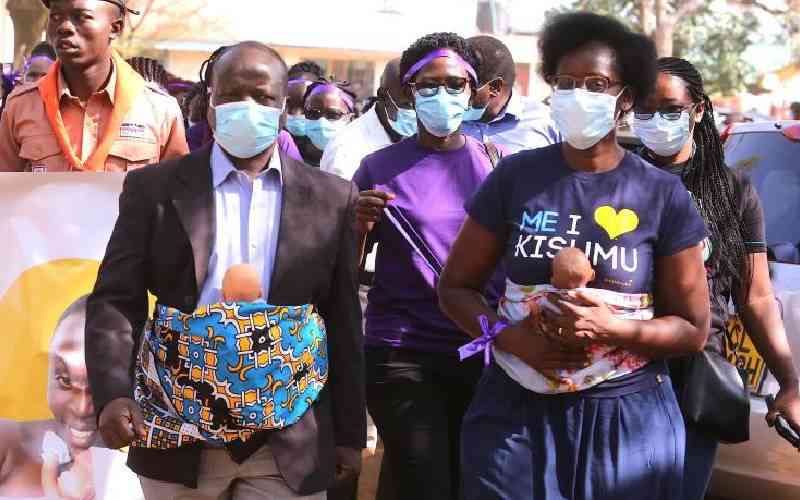It would have been joy when Anne and John Simiyu were blessed with twin boys.
However, born five weeks to term, the infants’ survival was hanging on a thin thread. They faced another threat at home, where relatives believed that it was not only a bad omen to have twins, but to have them born before time, and as the firstborns; a verdict was quickly reached, one of them had to die.
Anne was distressed. She owes the lives of her children to two people, her husband John, who took an active role in the infant’s welfare, and nurse Gladys Wanjala who introduced them to a natural means of taking care of infants born below the ideal birth weight of two and a half kilograms.
The Simiyu twins, born at the Siboti Health Centre in Bungoma both weighed below one and half kilograms. Nurse Wanjala knew immediately that she could not send the family home because of the double threat. She first thought of referring them to Bungoma County Referral Hospital where they would be put into incubators to help them gain weight.
Kangaroo mother care
“But the distressed mother was in no condition to travel, I thought of introducing them to Kangaroo Mother Care, and I am glad the couple embraced it.”
Kangaroo Mother Care (KMC), first practiced in Colombia in 1978, is inspired by the marsupial animal who care for their young ones, born prematurely, in a thermal-heated pouch. In humans, the infant is carried skin-to-skin by the mother and other family members can help, like John did with their twin boys.
“When I put the baby on KMC, I could feel it breathing... they became well and their colour became good,” says Anne.
Four weeks later, the babies were discharged having gained over 500 grams each, and the parents continued with KMC at home. The boys are among the lucky ones for every year. In Kenya, more than 180,000 babies are born premature and of these close to 15,000 die. Many of those who survive face a lifetime of diseases or disability.
These damning numbers put Kenya among the top fifteen countries with the highest number of preterm babies. Globally, about 15 million babies are born too soon each year and rates are increasing in most countries. Preterm are all births before 37 weeks. It is a leading cause of death among children under five in Kenya and around the world.
However, until recently, this tragedy remained almost invisible due to lack of data thus denying it the attention and action it deserves. In some parts of the country, myths and misconceptions about preterm babies make a bad situation worse.
The burden to families, communities, health system and the economy is too big to ignore any longer. Every newborn needs essential care comprising immediate and exclusive breastfeeding, warmth and hygienic cord and skin care. Those facing respiratory difficulties need help to initiate breathing.
Preterm babies are especially vulnerable and thousands could be saved if they received extra care. Managing severely premature babies involves intensive care, often requiring specialist skills and equipment such as incubators and respirators. Tragically, skilled staff and equipment are not always available in every health facility.
Incubators
Often incubators are insufficient and commonly babies have to share them, which may lead to cross-infection. Fortunately, a majority of preterm babies are moderately premature and can be saved with simple low-cost solutions that do not require incubators. Like in the case of the Simiyu twins, Kangaroo Mother Care could be the simple action that draws the line between life and death for many preterm babies.
Stay informed. Subscribe to our newsletter
The Ministry of Health is working with partners like Save the Children to scale up KMC to every health facility in Kenya. Already KMC has been introduced in over 20 counties and hundreds of health workers trained on the skill. In Bungoma County, where Save the Children is funded by the UK government under the County Innovation Challenge Fund to scale up KMC, communities have embraced it and dispelled myths that hitherto spelled doom for premature babies. Mothers and fathers whose preterm babies survived have become champions who not only encourage but also support others facing similar ordeal.
New evidence generated through research and innovation is opening new possibilities in the way prematurity is managed. For instance, recent studies have shown that the lives of tens of thousands of premature babies could be saved by simply delaying clamping the umbilical cord by one minute. There is also adequate evidence that donated human milk could save premature babies in situation where a mother dies or is not in a position to breastfeed.
Mr Karuga is the Technical Fund Manager, County Innovation Challenge Fund and Ms Nyamamu is the Communications Manager, Save the Children
 The Standard Group Plc is a
multi-media organization with investments in media platforms spanning newspaper
print operations, television, radio broadcasting, digital and online services. The
Standard Group is recognized as a leading multi-media house in Kenya with a key
influence in matters of national and international interest.
The Standard Group Plc is a
multi-media organization with investments in media platforms spanning newspaper
print operations, television, radio broadcasting, digital and online services. The
Standard Group is recognized as a leading multi-media house in Kenya with a key
influence in matters of national and international interest.
 The Standard Group Plc is a
multi-media organization with investments in media platforms spanning newspaper
print operations, television, radio broadcasting, digital and online services. The
Standard Group is recognized as a leading multi-media house in Kenya with a key
influence in matters of national and international interest.
The Standard Group Plc is a
multi-media organization with investments in media platforms spanning newspaper
print operations, television, radio broadcasting, digital and online services. The
Standard Group is recognized as a leading multi-media house in Kenya with a key
influence in matters of national and international interest.







